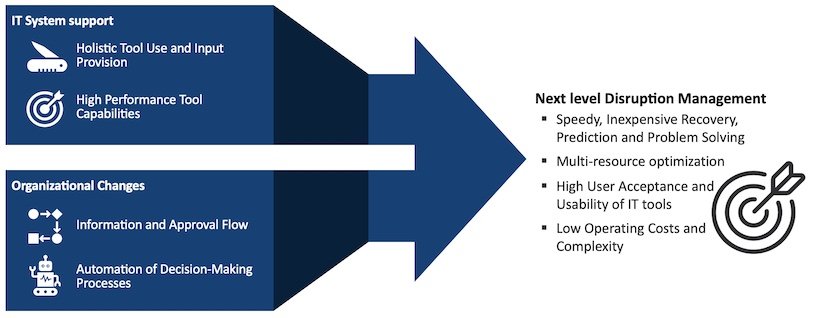
How Airlines Will Benefit from Next-level Disruption Management
Introduction
The complexity of Airline Operations has steadily increased over the past decades. Modern-day airlines fly to hundreds of destinations with many different types of ever more complex aircraft, relying on a large number of internal and external service providers. Furthermore, hub and spoke carriers have established highly sophisticated hub operations, connecting passengers to even more destinations worldwide. While this system has been brought to perfection to run like a clockwork under regular circumstances, it is prone to skip a beat on any irregularity in the process. Unfortunately, once a failure occurs, it trickles through the entire chain, from suppliers to airlines to passengers. And conversely, a sick crew member or a single passenger coming in late may delay an entire aircraft rotation.
In 2018, total cost from disruptions in airline schedules worldwide amounted to an estimate of more than $60 bn, of which more than $32 bn were due to avoidable causes. For carriers like British Airways, a single day of closure at London Heathrow airport – as happened several times during 2017 with more than 100.000 passengers stranded – costs more than £42m in fallout, affecting the airline’s schedules for days after. Airlines increasingly turn towards sophisticated IT systems to help them tackle such disruptions, as well as streamlined operations control structures, and dedicated disruption response teams. Major players such as American Airlines or Lufthansa have built new Integrated Operations Centers (IOC) and interconnected IT systems, striving to minimize disruption response time. Others try to prevent disruptions by maintaining larger reserves and buffered flight schedules – a highly effective, but costly remedy.
Current practices for disruption recovery are manifold, and lead to varying results. However, learnings from academic research, as well as from daily operations suggest outlines of a dawning new disruption recovery vision, providing airlines of tomorrow with cost savings and differentiation potential.To identify the optimum recovery solution, all relevant resources need to be included in respective optimization models. This applies to the four operational spheres aircraft availability / maintenance need, aircraft rotation, crew duty plans, and passenger connections. Past studies have shown that identifying the global optimum including all resources at once leads to theoretically ideal solutions. However, in the majority of cases target functions become insolvably complex or runtimes are infeasible. Optimizing step by step and resource by resource leads to less optimal solutions in the first place, but learnings can be used to calibrate global optimization frameworks and thus reduce mathematical disadvantages and runtimes in the long run.
Next-level Disruption Management leads to reduced failure costs since even complex disruptions can be handled faster and in a more automated way.

Identifying the right balance between computational optimization and feasibility in an extremely volatile environment is a key element of next level Disruption Management solutions and needs to be accomplished based on airline-specific set-ups. Recovery solutions also need to be set up in an Operations Controller friendly way that fosters high user acceptance. Dedicated business cases for recovery solutions must be calculated to allow the right balance of initial and operating costs compared to actual savings.
Upgrade IT System Support
To establish a seamless and comprehensive recovery process for operations control staff, the next generation of disruption recovery tools should enable a human controller to take a prompt decision, based on all available information for a given situation, having evaluated multiple recovery scenarios with predictions on spillover and trickle-down effects. Once the decision is made, a sequence of actions must be immediately initiated, ideally carried out autonomously by the system. The inherent interdependency of processes and resources in the travel industry, as well as its delicately fine-tuned value chains require every available support to work just-in-time. As the individual components become more detailed and more extensive at the same time, human capabilities in processing data and evaluate solutions find their limits. Data are already transmitted through web-based services, such as meteorological data or flight tracking. Moreover, airlines include several data inputs in their decision making, ranging from environmental data to technical information about aircraft maintenance. Also, communication has recently been pushed to function exclusively by electronic means in a standardized and controlled way. A next-generation Disruption Management system should therefore contain a comprehensive, integrated, and fully automated information center, suited to eliminate information uncertainty, and to enable fast, reliable decisions, through:
- Data Pooling: Automatically gather all available information and pool it into a minable data platform. Ideally, the platform gathers both structured internal and external data sources, but also picks up unstructured information from other relevant sources such as airport or traffic data. The process should be carried out continuously without human intervention and upon availability of any data update.
- Prediction: Continuously analyze and predict the effects on operations and warn the controllers of upcoming risks, up to 48h in advance, and in a fully automated mode. Ideally, control staff should be enabled to act rather than only react. Predicted risks must be translated into actionable recommendations for operations control staff, while minor adjustments with limited risk exposure are implemented directly by the algorithms. Reducing workload and increasing lead time is the key success factor in this context.
- Optimal Recovery: Build and align an optimal solution to recover operations along different dimensions. A global optimum that includes multiple resources such as aircraft, crews and passengers may lead to theoretical solutions which are not viable in practice. Partial solutions decrease the quality of results but are easier to manage. Potent disruption solvers must be able to balance the trade-off between feasibility and quality of implementation. Likewise, the solver must allow high-speed calculation, since the volatile environment in disruptions changes with every minute.
- Scenario Building: Prepare possible recovery scenarios with a comprehensive overview of the consequences of implementation. Scenarios can be constructed in advance for predicted risks, enabling operations control staff to react quickly as soon as scenarios become reality. Furthermore, scenarios are needed to calibrate parameters of optimization models as a recurring task.
- Communication: Inform all stakeholders once a decision by operations control staff is taken, provide them with information about all effects on their own operations. This should include schedule changes, tail and crew-assignments, changes in passenger journeys, costs, and many more.
- Continuous Learning: Automatically feed information about a decision to the information sources as required and include the effects into an intelligent learning algorithm for the optimization of future prediction.
Streamline the Organization
To maximize the potential of an IT system in disruption recovery, the processes as well as the underlying organization should support information flows across teams. By sharing available information without artificial obstacles, the organization can facilitate quick and effective decisions.Studies have uncovered inefficiencies in data sharing across almost all organizations. Structural obstacles can be found in hierarchies, in the steps required for decision making, or unclear responsibilities for process steps. Current trends in organizational design point towards a single unit holding the entire responsibility for disruption management.An efficient, responsive organizational structure for next generation disruption management should therefore evolve around the following key levers:
- Communication: Facilitate communication on a working level by bringing together the relevant experts and controllers – physically and by information
- Decision Making: Streamline decision making by removing as many approval steps as possible without decreasing decision quality. Today, human staff still spends the majority of its time on scenario building and subsequent evaluation. Next-level disruption management must empower them to migrate from an analytical role to a decision role,relying on sophisticated IT-tools for the analytical tasks. By advancing to a decision maker, operations control staff can decrease the time spent on scenario analysis and implementation, and thereby have more spare resources to focus on critical and impactful disruptions. Advanced IT-tools should become a kind of autonomous co-worker for controllers, being monitored by the real decision makers.
- Competence Center: Centralize responsibility for different tasks in disruption recovery, involving relevant experts whenever required. A central expert panel for different situations should be created, bringing deep expertise from different areas (such as Fleet, Passenger, Crew, Financial) to the table.
Time to Act
A next-level disruption management practice is prepared to significantly improve the efficiency and speed of recovery processes, thus avoiding considerable portions of the potential irregularity costs. Furthermore, it may raise the convenience of alternative solutions for passengers, thus boosting customer satisfaction and loyalty. Every traveler knows that things can go wrong; however, travelers expect at least a professional and timely management of the problem.To achieve this target, airlines need to treat disruption recovery as a top priority issue, fostered by executive sponsors, and meticulously pursued with the involvement of all internal stakeholders. Besides management attention and coordination across functions and hierarchical levels, advanced IT tools such as integrated solver solutions are key to extract the full value of future disruption management practices. Furthermore, these tools demand a consistent and ideally real-time data base. Future Disruption Management tools should include predictive functions, enabling operations control staff to switch from a merely reactive to a more powerful pro-active working mode. Disruptions that can be fixed before they occur are usually the cheapest and least impactful disruptions!Finding viable recover solutions for the four disruption layers – aircraft, rotation, crew, passengers – will add huge value. However, an integrated solution may be even more beneficial because is searches the global optimum for the disruption problem. Thus, next-level disruption management tools include the capability of evaluating both individual (per resource layer) and overall scenarios. The aforementioned measures require substantial resources, but those are well invested given the potential gains of a well-executed recovery system. Managers need to empower operations control staff by providing integrated tool support, appropriate training, and a targeted transformation process.




